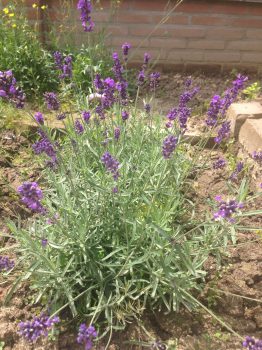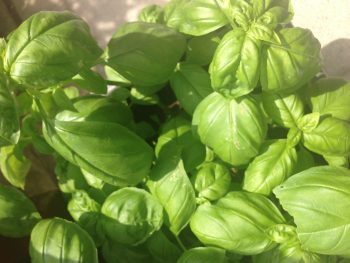Dutch Gardens Part 2- Fruits, Veggies and Herbs Posted by Karoly Molina on Jul 13, 2016 in Culture, Dutch Vocabulary
On my previous post, I wrote about basic components of a Dutch garden. These included a seating area, flowers, a moestuin and a covered area to protect from the sun and rain. On this post, I would like to expand more on the moestuin.
The moestuin is the healthiest and most fruitful part of the garden. If you grew up in a city or in an area with extreme weather, watching your veggies grow is a novelty. You can start the moestuin from the very beginning, by using zaden or seeds. I personally haven’t had much luck starting from seeds, so I just buy small plants and put them in the garden.

Lavandel (personal photograph)
The choice of groente and kruiden are usually based on personal taste and the weather. Lavandel is a very versatile plant because it attracts bijen and vlinders, survives the winter and gives a great aroma to desserts and even iced water (suggestion: fill a pitcher with water, some mint leaves and some lavender flowers and put it in the fridge…refreshing!!)
Munt and citroenmelisse are also very easy to have in the garden. There are different types of mint, and both grow very quickly. I suggest you keep munt in a limited area (say a small flowerbed or a pot) because it grows fast. Last year, my mint plants lasted all the way until December which meant I always had verse munt thee at home! The citroenmelisse seems to be less invasive but it did grow a lot more than I had allotted space for.
Rucola is a crazy amazing plant to have! It seems to love Dutch weather because I bought a tiny little plant at the garden store and now I have a bush of rucola!
Salie or sage is a fighter plant! This one survived all winter (although it looked kind of sad at some point) and regrew as soon as the weather warmed up. Thijm and oregano are also very easy to take care of and require little space.

Basilicum (personal photograph)
Basilicum is perhaps my favorite herb, but one that requires more attention. You shouldn’t put the plant outside before May because one unusually cold night can kill it. Both the purple and the green variations are thriving right now.
Uien are one of my favorite to cook with and the most difficult to pronounce (at least when I was learning Dutch). The little bulbs quickly grew to proper onion plants and are ready to be pulled and eaten!

Tomaten (personal photograph)
I have saved my favorite for last…tomaten. My experience with both trostomaten and kerstomaten has been one of love. Tomaten don’t require too much attention, simply a very sturdy support system to let them grow. Last year we had so many tomatoes to eat which meant I learned many recipes that call for tomatoes. Even our cat Mona loved the tomato plants and relaxes with them during the sunny days.
Around our neighborhood, I have also seen many perenbomen, appelbomen and even kastanjebomen. The possibilities of organic, home grown herbs, fruits and veggies are endless!
What do you like to grow in your garden?

Build vocabulary, practice pronunciation, and more with Transparent Language Online. Available anytime, anywhere, on any device.
About the Author: Karoly Molina
Since I was a little girl, I was fascinated with languages and writing. I speak English, Spanish, Italian, Dutch and a little bit of French. I am a writer, reader, language teacher, traveler, and a food lover! I now live in The Netherlands with my husband Riccardo, our cat Mona, and our dog Lisa, and the experience has been phenomenal. The Dutch culture is an exciting sometimes topsy-turvy world that I am happily exploring!




Comments:
Bill (Papa Van Twee):
We live in the “VSA” but my wife is Dutch. We have some lavendel and munt (and chives) just outside our back door. We have two plots of land for “groente”, too, which has tomatoes, kale, peas, strawberries, etc. Most of our backyard is grass, however, as well as the front. We to have some trees, bushes, flowers and tall grass in the front.